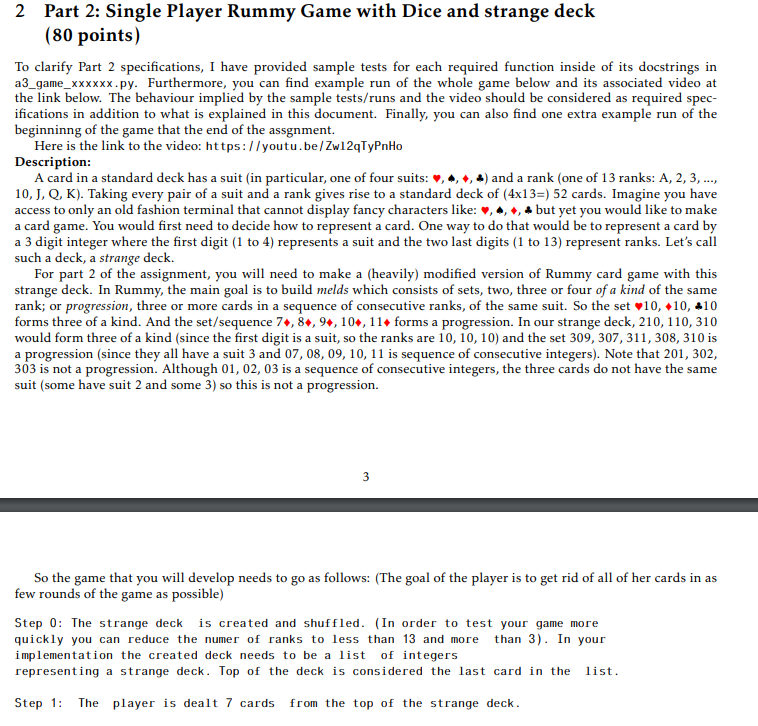Question
This Code is in Python Here is the docstrings in this question import random # Read and understand the docstrings of all of the functions
This Code is in Python
Here is the docstrings in this question
import random
# Read and understand the docstrings of all of the functions in detail.
def make_deck(num): '''(int)->list of int Returns a list of integers representing the strange deck with num ranks.
>>> deck=make_deck(13) >>> deck [101, 201, 301, 401, 102, 202, 302, 402, 103, 203, 303, 403, 104, 204, 304, 404, 105, 205, 305, 405, 106, 206, 306, 406, 107, 207, 307, 407, 108, 208, 308, 408, 109, 209, 309, 409, 110, 210, 310, 410, 111, 211, 311, 411, 112, 212, 312, 412, 113, 213, 313, 413]
>>> deck=make_deck(4) >>> deck [101, 201, 301, 401, 102, 202, 302, 402, 103, 203, 303, 403, 104, 204, 304, 404] ''' pass
def shuffle_deck(deck): '''(list of int)->None Shuffles the given list of strings representing the playing deck
Here you should use random.shuffle function from random module. Since shufflling is random, exceptionally in this function your output does not need to match that show in examples below:
>>> deck=[101, 201, 301, 401, 102, 202, 302, 402, 103, 203, 303, 403, 104, 204, 304, 404] >>> shuffle_deck(deck) >>> deck [102, 101, 302, 104, 304, 103, 301, 403, 401, 404, 203, 204, 303, 202, 402, 201] >>> shuffle_deck(deck) >>> deck [402, 302, 303, 102, 104, 103, 203, 301, 401, 403, 204, 101, 304, 201, 404, 202] ''' pass
def deal_cards_start(deck): '''(list of int)-> list of int
Returns a list representing the player's starting hand. It is obtained by dealing the first 7 cards from the top of the deck. Precondition: len(dec)>=7 ''' pass
def deal_new_cards(deck, player, num): '''(list of int, list of int, int)-> None Given the remaining deck, current player's hand and an integer num, the function deals num cards to the player from the top of the deck. If the number of cards in the deck is less than num then then all the remaining cards are from the deck. Precondition: 1>> deck=[201, 303, 210, 407, 213, 313] >>> player=[302, 304, 404] >>> deal_new_cards(deck, player, 4) >>> player [302, 304, 404, 313, 213, 407, 210] >>> deck [201, 303] >>>
>>> deck=[201, 303] >>> player=[302, 304, 404] >>> deal_new_cards(deck, player, 4) >>> player [302, 304, 404, 303, 201] >>> deck [] ''' pass
def print_deck_twice(hand): '''(list)->None Prints elements of a given list deck in two useful ways. First way: sorted by suit and then rank. Second way: sorted by rank. Precondition: hand is a subset of the strange deck. Your function should not change the order of elements in list hand. You should first make a copy of the list and then call sorting functions/methods.
Example run: >>> a=[311, 409, 305, 104, 301, 204, 101, 306, 313, 202, 303, 410, 401, 105, 407, 408] >>> print_deck_twice(a)
101 104 105 202 204 301 303 305 306 311 313 401 407 408 409 410
101 301 401 202 303 104 204 105 305 306 407 408 409 410 311 313 >>> a [311, 409, 305, 104, 301, 204, 101, 306, 313, 202, 303, 410, 401, 105, 407, 408]
''' pass
def is_valid(cards, player): '''(list of int, list of int)->bool Function returns True if every card in cards is the player's hand. Otherwise it prints an error message and then returns False, as illustrated in the followinng example runs.
Precondition: cards and player are subsets of the strange deck. >>> is_valid([210,310],[201, 201, 210, 302, 311]) 310 not in your hand. Invalid input False
>>> is_valid([210,310],[201, 201, 210, 302, 310, 401]) True ''' pass
def is_discardable_kind(cards): '''(list of int)->True Function returns True if cards form 2-, 3- or 4- of a kind of the strange deck. Otherwise it returns False. If there is not enough cards for a meld it also prints a message about it, as illustrated in the followinng example runs. Precondition: cards is a subset of the strange deck.
In this function you CANNOT use strings except in calls to print function. In particular, you cannot conver elements of cards to strings. >>> is_discardable_kind([207, 107, 407]) True >>> is_discardable_kind([207, 107, 405, 305]) False >>> is_discardable_kind([207]) Invalid input. Discardable set needs to have at least 2 cards. False ''' pass
def is_discardable_seq(cards): '''(list of int)->True Function returns True if cards form progression of the strange deck. Otherwise it prints an error message and then returns False, as illustrated in the followinng example runs. Precondition: cards is a subset of the strange deck.
In this function you CANNOT use strings except in calls to print function. In particular, you cannot conver elements of cards to strings.
>>> is_discardable_seq([313, 311, 312]) True >>> is_discardable_seq([311, 312, 313, 414]) Invalid sequence. Cards are not of same suit. False >>> is_discardable_seq([201, 202]) Invalid sequence. Discardable sequence needs to have at least 3 cards. False >>> is_discardable_seq([]) Invalid sequence. Discardable sequence needs to have at least 3 cards. False ''' pass
def rolled_one_round(player): '''(list of int)->None This function plays the part when the player rolls 1 Precondition: player is a subset of the strange deck
>>> #example 1: >>> rolled_one_round(player) Discard any card of your choosing. Which card would you like to discard? 103 103 No such card in the deck. Try again. Which card would you like to discard? 102
Here is your new hand printed in two ways:
201 212 311
201 311 212
''' pass
def rolled_nonone_round(player): '''(list of int)->None This function plays the part when the player rolls 2, 3, 4, 5, or 6. Precondition: player is a subset of the strange deck
>>> #example 1: >>> player=[401, 102, 403, 104, 203] >>> rolled_nonone_round(player) Yes or no, do you have a sequences of three or more cards of the same suit or two or more of a kind? yes Which 3+ sequence or 2+ of a kind would you like to discard? Type in cards separated by space: 102 103 104 103 not in your hand. Invalid input Yes or no, do you have a sequences of three or more cards of the same suit or two or more of a kind? yes Which 3+ sequence or 2+ of a kind would you like to discard? Type in cards separated by space: 403 203
Here is your new hand printed in two ways:
102 104 401
401 102 104 Yes or no, do you have a sequences of three or more cards of the same suit or two or more of a kind? no
>>> #example 2: >>> player=[211, 412, 411, 103, 413] >>> rolled_nonone_round(player) Yes or no, do you have a sequences of three or more cards of the same suit or two or more of a kind? yes Which 3+ sequence or 2+ of a kind would you like to discard? Type in cards separated by space: 411 412 413
Here is your new hand printed in two ways:
103 211
103 211 Yes or no, do you have a sequences of three or more cards of the same suit or two or more of a kind? no
>>> #example 3: >>> player=[211, 412, 411, 103, 413] >>> rolled_nonone_round(player) Yes or no, do you have a sequences of three or more cards of the same suit or two or more of a kind? yes Which 3+ sequence or 2+ of a kind would you like to discard? Type in cards separated by space: 411 412 Invalid meld: 11 is not equal to 12 Invalid sequence. Discardable sequence needs to have at least 3 cards.
>>> #example 4: >>> player=[401, 102, 403, 104, 203] >>> rolled_nonone_round(player) Yes or no, do you have a sequences of three or more cards of the same suit or two or more of a kind? alsj Yes or no, do you have a sequences of three or more cards of the same suit or two or more of a kind? hlakj Yes or no, do you have a sequences of three or more cards of the same suit or two or more of a kind? 22 33 Yes or no, do you have a sequences of three or more cards of the same suit or two or more of a kind? no ''' pass
# main print("Welcome to Single Player Rummy with Dice and strange deck. ") size_change=input("The standard deck has 52 cards: 13 ranks times 4 suits. Would you like to change the number of cards by changing the number of ranks? ").strip().lower()
# YOUR CODE GOES HERE and in all of the above functions instead of keyword pass



Step by Step Solution
There are 3 Steps involved in it
Step: 1

Get Instant Access to Expert-Tailored Solutions
See step-by-step solutions with expert insights and AI powered tools for academic success
Step: 2

Step: 3

Ace Your Homework with AI
Get the answers you need in no time with our AI-driven, step-by-step assistance
Get Started


